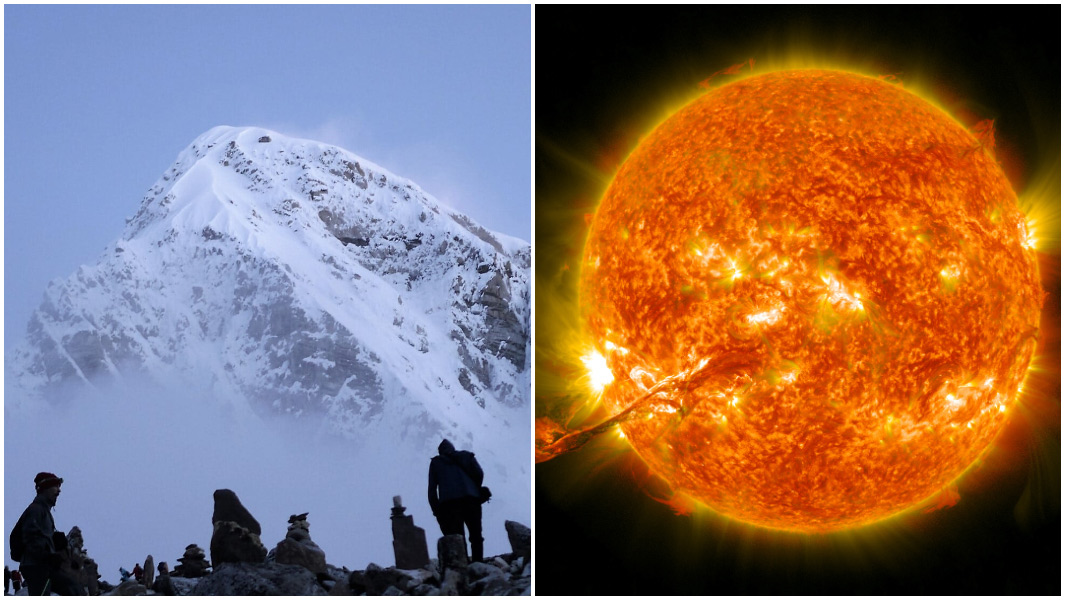Five completely false ‘facts’ you still believe

Forget everything you thought you knew.
The Sun isn’t yellow and the sky isn’t blue.
The largest desert has zero sand and the tallest mountain is lower than the highest one.
If none of this makes sense to you, you’re in the right place. Here are five 'facts' you need to unlearn.

Mount Everest is the world’s tallest mountain
With its peak at an altitude of 8,848 metres (29,029 ft) above sea level, Mount Everest (aka Sagarmāthā or Chomolungma) is the world’s highest mountain.
But it’s not the tallest mountain in the world.
That title belongs to Mauna Kea (White Mountain) in Hawaii, USA. It measures 10,205 metres (33,480 ft) tall, although almost 60% of it is underwater.
Mauna Kea's peak is 4,205 metres (13,796 ft) above sea level, though there is still some debate as to exactly where its base begins.
While the depth of the sea floor around the island’s shores ranges from 2,000-3,000 fathoms (3,657-5,486 metres), the deepest point in the local region is a small trough called the Hawaiian Deep.
Here, the sea floor sinks to a further depth of 3,280 fathoms (6,000 metres), which was the figure used when calculating Mauna Kea’s total height.
So Mauna Kea is taller than Everest, but surely Everest is still the farthest mountain peak from Earth’s centre?
Well, no.
The summit of Chimborazo, in the Andes, is technically the farthest mountain peak from Earth’s centre, despite being only 6,310 metres (20,702 ft) high.

The explanation lies in its location being just 158 kilometres (98 miles) south of the equator.
The Earth has a slight equatorial bulge, meaning it’s about 43 kilometres (27 miles) wider at the equator than it is pole-to-pole. This is due to the centrifugal force generated by our planet’s rotation, which forms it into an oblate spheroid; a shape akin to a lentil or an M&M®.
Whilst this difference is too small to notice visually, it means that Chimborazo is 6,384 kilometres (3,967 miles) from Earth’s centre, which is 2,150 metres (7,054 ft) further than Mount Everest’s peak.
As if that wasn’t enough, did you know you’ve been pronouncing Everest wrong too?
It was named after Col. Sir George Everest (1790-1866), formerly Surveyor-General of India (1830-43), who pronounced his name Eve-rest.

The Sun is yellow
At the centre of our solar system is the Sun – our world’s closest star.
149 million kilometres (92.9 million miles) away from Earth, it appears yellow or orange in colour to most of us. But looks can be deceiving, so what colour is it really?
The Sun emits all colours of visible light, meaning it is actually white.
However, the Earth’s atmosphere scatters blue light more efficiently than red light. This slight deficit causes our eyes to perceive the Sun as being yellow.
This is also why the sky appears blue during the daytime, as blue wavelengths are scattered more than any other colour.

Napoleon was short
Napoleon Bonaparte was famous for many things.
His iconic bicorn hat, worn at the 1800 Battle of Marengo, Italy, is the most expensive hat sold at auction, fetching €1.8 million ($2.3 m; £1.5 m) in 2014.
The sword he carried into that same battle is the most expensive weapon sold at auction. The French Emperor’s curved steel blade was sold by one branch of his descendants to another for €4.8 million (£3.3 m; $6.5 m) in 2007.
However, Napoleon is perhaps most famous for being short. But was he really?
Well, kind of.
Despite being shorter than his soldiers, at 1.57 metres (5 ft 2 in) he was the height of an average 19th century French male.
Additionally, some interpretations of Napoleon’s death certificate estimate that his height when he died was actually closer to being 1.7 metres (5 ft 7 in).
This discrepancy is due to the 19th-century French inch (2.71 centimetres) being larger than our current inch measurement of 2.54 centimetres.
Doubts about this remain though, as Napoleon was measured to be 1.57 metres (5 ft 2 in) during his exile on the British-owned island of St Helena, where an English yardstick was most likely used.

OMG is a modern expression
"OMG" is sure to be your reaction after reading this fun fact.
According to the Oxford English Dictionary, the first instance of "OMG" in print was in 1917, in a letter sent to Winston Churchill, then the UK’s Minister of Munitions.
Written on 9 September 1917 by 76-year-old Admiral John "Jacky" Fisher (UK), it read: "I hear that a new order of Knighthood is on the tapis – O.M.G. (Oh! My God!) – Shower it on the Admiralty!"
"Tapis" is a reference to "tablecloth", thus "on the tapis" means "on the table".
The first documented online use of "OMG" was on 24 September 1994, on the rec.arts.tv.soaps Newsnet newsgroup: "OMG! what did I say".

The Sahara is the world's largest desert
A desert is any barren area of land that experiences little to no rainfall.
By this definition, the world’s largest desert is the Antarctic ice sheet, covering approximately 98% of Antarctica (14 million km²; 5.4 million sq mi).
It holds this title despite also being the world’s largest body of fresh water, holding 30 million km³ (7.25 million mi³) of frozen water, or 70% of the world’s total.
The ice sheet also holds the record for the driest cold desert, with Antarctica being the world’s driest continent, receiving annual precipitation of as little as 50 millimetres (2 inches).
By comparison, the Sahara, the largest hot desert (9.1 million km2; 3.5 million sq mi), experiences 100–250 millimetres (4–10 inches) per year on average.
A fact that won’t surprise you is the Antarctic ice sheet being the world’s coldest desert. According to the British Antarctic Survey, winter temperatures on the coast average -10 to -30°C (14 to -22°F) and can plummet to beyond -60°C (-76°F) farther inland.


